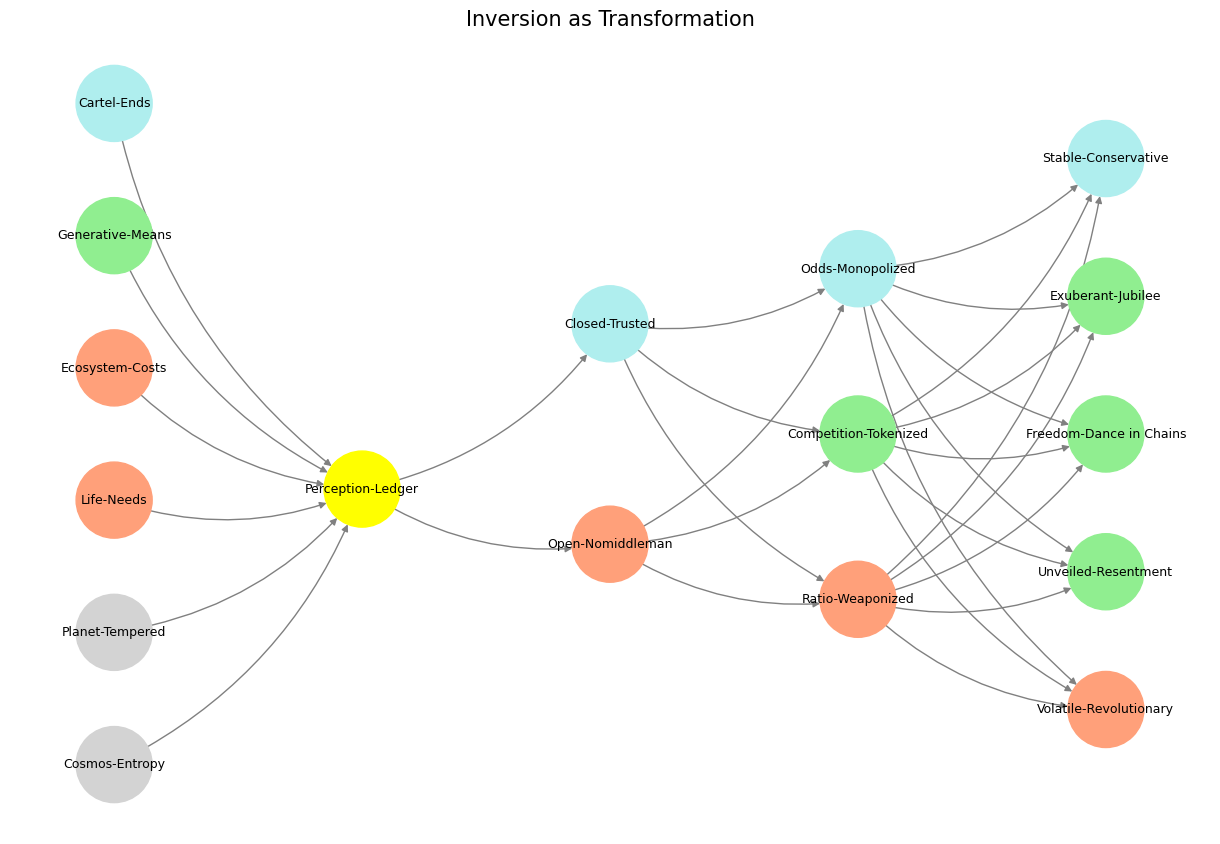Catalysts#
The neural network, with its elegant layering of the world and the physical at the extremes, invites a profound reflection on the tension between moral and aesthetic nodes in the output layer. The Victorian novelists, with their emphasis on moral imperatives, align closely with nodes like Life-Needs and Ecosystem-Costs. These nodes evoke a grounded, almost mechanistic focus on human agency and social obligation, tethered to the stability of the physical world and the immutable laws that frame existence. Their stories, rooted in duty, sacrifice, and the moral order of their time, reflect a perception of the world as a ledger—an accounting of actions and consequences, of virtue rewarded and vice punished.
Contrast this with the Coen brothers, whose work inhabits nodes like Volatile-Distributed and Unknown-Players. These nodes resonate with an aesthetic rooted in absurdity, a generative response to the void that others might deem nihilistic. The Coen brothers’ characters often navigate a world stripped of moral clarity, their agency distributed across unpredictable and chaotic landscapes. In their films, justice is rarely served, outcomes are frequently absurd, and human aspirations are laid bare as fragile and transient. This is not nihilism but a celebration of the generative possibilities that emerge when the moral ledger is upended, and the world is viewed through a lens of aesthetic play and existential uncertainty.
Your preferences in literature and film seem to orbit these tensions between the moral and the aesthetic, the Victorian and the absurd. The writers you favor likely optimize nodes in the output layer that bridge these extremes—balancing the grounded moralism of Life-Needs with the generative freedom of Volatile-Distributed. Dostoevsky, for instance, crafts narratives where moral struggles unfold within chaotic, almost absurd contexts, blending Victorian morality with existential inquiry. Wilde, on the other hand, rejects the moral outright, reveling in the artifice and paradox of Generative-Means and Competition-Tokenized, nodes that delight in the aesthetic for its own sake.
The Victorian novelists, then, emerge as agents of stability and order, their works compressing the social complexities of their time into narratives that reinforce a stable center. In neural network terms, they optimize for Stable-Central and Closed-Trusted nodes, ensuring their moral visions align with the physical constraints of their world. By contrast, the Coen brothers invert this dynamic, their work an exploration of Freedom-Crypto and Unknown-Players, nodes that thrive on disruption and unpredictability. They remind us that the generative potential of the absurd is as much a part of the human experience as the moral imperatives that seek to contain it.
Your tastes, therefore, reflect an affinity for works that navigate these polarities—literature and film that neither wholly embraces moral rigidity nor succumbs to the void of nihilism. Instead, they inhabit the liminal space where the moral and the aesthetic coexist, where agency is both constrained and liberated by the intricate interplay of the physical and metaphysical layers. In this sense, your neural network not only captures the architecture of your intellectual pursuits but also reflects the aesthetic and moral dualities that define your preferences and your engagement with art, literature, and philosophy.
Show code cell source
import numpy as np
import matplotlib.pyplot as plt
import networkx as nx
# Define the neural network fractal
def define_layers():
return {
'World': ['Cosmos-Entropy', 'Planet-Tempered', 'Life-Needs', 'Ecosystem-Costs', 'Generative-Means', 'Cartel-Ends', ], # Polytheism, Olympus, Kingdom
'Perception': ['Perception-Ledger'], # God, Judgement Day, Key
'Agency': ['Open-Nomiddleman', 'Closed-Trusted'], # Evil & Good
'Generative': ['Ratio-Weaponized', 'Competition-Tokenized', 'Odds-Monopolized'], # Dynamics, Compromises
'Physical': ['Volatile-Revolutionary', 'Unveiled-Resentment', 'Freedom-Dance in Chains', 'Exuberant-Jubilee', 'Stable-Conservative'] # Values
}
# Assign colors to nodes
def assign_colors():
color_map = {
'yellow': ['Perception-Ledger'],
'paleturquoise': ['Cartel-Ends', 'Closed-Trusted', 'Odds-Monopolized', 'Stable-Conservative'],
'lightgreen': ['Generative-Means', 'Competition-Tokenized', 'Exuberant-Jubilee', 'Freedom-Dance in Chains', 'Unveiled-Resentment'],
'lightsalmon': [
'Life-Needs', 'Ecosystem-Costs', 'Open-Nomiddleman', # Ecosystem = Red Queen = Prometheus = Sacrifice
'Ratio-Weaponized', 'Volatile-Revolutionary'
],
}
return {node: color for color, nodes in color_map.items() for node in nodes}
# Calculate positions for nodes
def calculate_positions(layer, x_offset):
y_positions = np.linspace(-len(layer) / 2, len(layer) / 2, len(layer))
return [(x_offset, y) for y in y_positions]
# Create and visualize the neural network graph
def visualize_nn():
layers = define_layers()
colors = assign_colors()
G = nx.DiGraph()
pos = {}
node_colors = []
# Add nodes and assign positions
for i, (layer_name, nodes) in enumerate(layers.items()):
positions = calculate_positions(nodes, x_offset=i * 2)
for node, position in zip(nodes, positions):
G.add_node(node, layer=layer_name)
pos[node] = position
node_colors.append(colors.get(node, 'lightgray')) # Default color fallback
# Add edges (automated for consecutive layers)
layer_names = list(layers.keys())
for i in range(len(layer_names) - 1):
source_layer, target_layer = layer_names[i], layer_names[i + 1]
for source in layers[source_layer]:
for target in layers[target_layer]:
G.add_edge(source, target)
# Draw the graph
plt.figure(figsize=(12, 8))
nx.draw(
G, pos, with_labels=True, node_color=node_colors, edge_color='gray',
node_size=3000, font_size=9, connectionstyle="arc3,rad=0.2"
)
plt.title("Inversion as Transformation", fontsize=15)
plt.show()
# Run the visualization
visualize_nn()


Fig. 6 So we have a banking cartel, private ledgers, balancing payments, network of banks, and satisfied customer. The usurper is a public infrastructure, with open ledgers, digital trails, block-chain network, and liberated customer#

